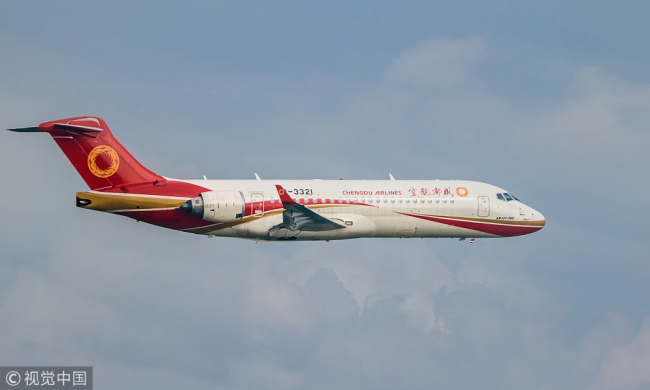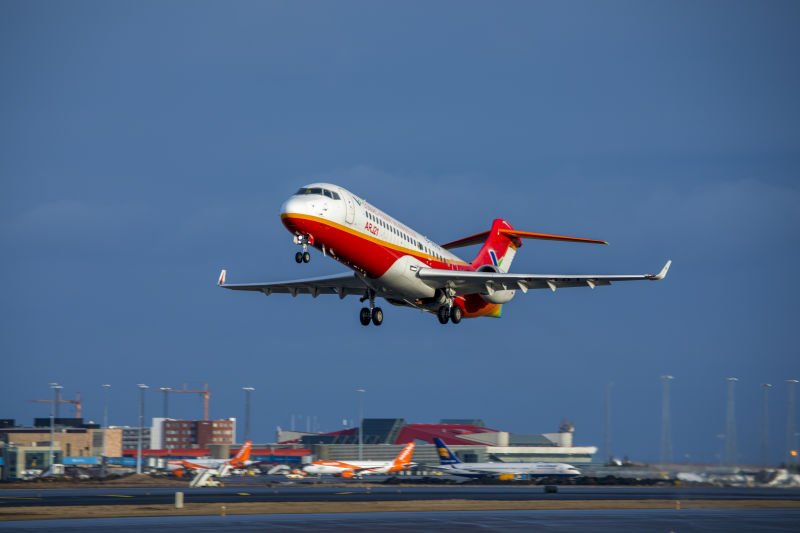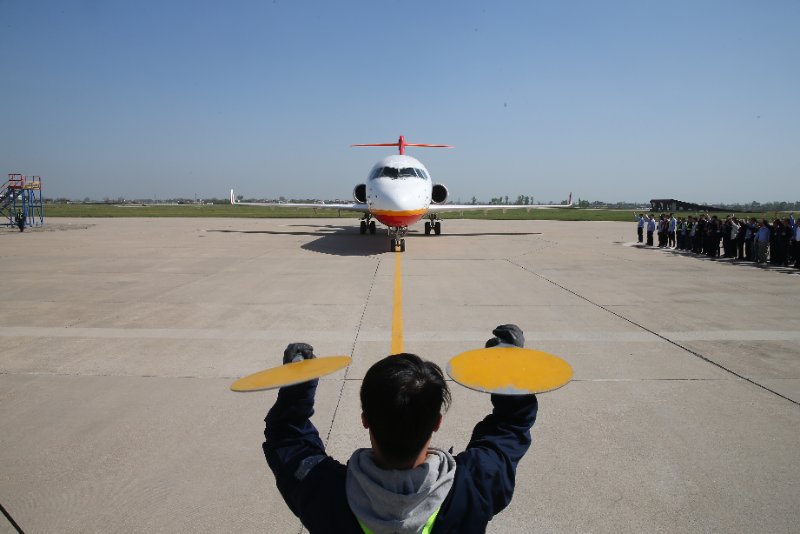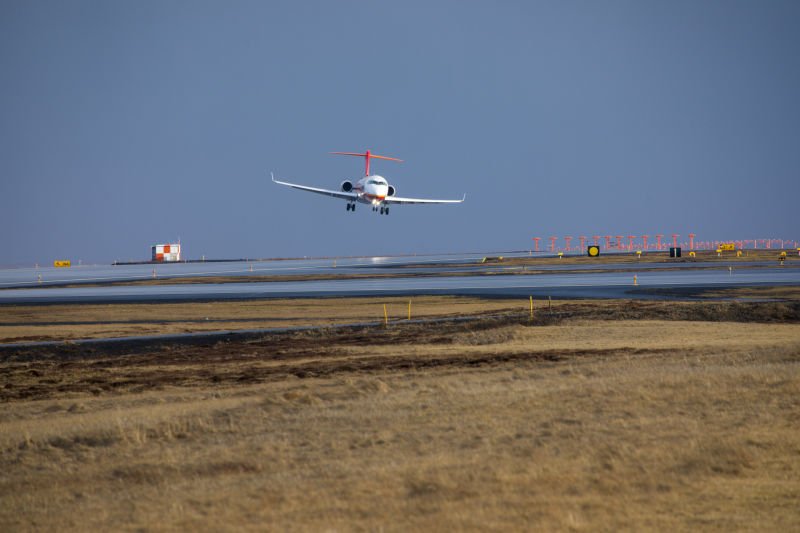You are using an out of date browser. It may not display this or other websites correctly.
You should upgrade or use an alternative browser.
You should upgrade or use an alternative browser.
Chinese Aviation Industry
- Thread starter FriedRiceNSpice
- Start date
asif iqbal
Banned Idiot
I’m surprised they took this long to do this test ?
It’s already flying commercial flights
It’s already flying commercial flights
I’m surprised they took this long to do this test ?
It’s already flying commercial flights
They were done, but not to the maximum and from what I read these recent tests were added in order to expand the so far validated limits of 22kt crosswinds during testing in China. Altogether the tests involved six takeoffs and landings at an average takeoff crosswind of 38.4kts and an average landing crosswind of 34.9kts. The maximum verified crosswind was 48.7kts, exceeding the aircraft’s design limits of 30kt for take-offs and 27kt for landing.
Hendrik_2000
Lieutenant General
They were done, but not to the maximum and from what I read these recent tests were added in order to expand the so far validated limits of 22kt crosswinds during testing in China. Altogether the tests involved six takeoffs and landings at an average takeoff crosswind of 38.4kts and an average landing crosswind of 34.9kts. The maximum verified crosswind was 48.7kts, exceeding the aircraft’s design limits of 30kt for take-offs and 27kt for landing.
Yes it increase the envelope where the aircraft can be used .Plus during testing there is no place in China that has 37 kts cross wind So they have to go all the way to Iceland because that is the only place with more than 30 kts cross wind
:

In April 9th, the leading isothermal forging machine in the aviation industry started production in the aviation industry. In April 9th, the leading isothermal forging press in China started production in the aviation industry. It marked an important improvement in the forging capability of the isotherm, and developed the forging parts in the direction of "high quality, precision, high efficiency and environmental protection", and made a solid effort to form the core competitiveness of the products. A step。 After being put into production, the equipment will greatly meet the forming needs of the complex forgings of difficult deformable materials such as titanium alloy and high temperature alloy in our country. It will effectively promote the research and development of large isothermal forging technology in the fields of aviation, space, ship and wind power, and effectively solve the passive situation in which some of the core components of domestic equipment depend on the import for a long time. It has important strategic significance to realize the domestic independent development of large isothermal forging disk shaft parts.

This explains why the ARj21 went in Iceland.
Rolls-Royce to bid for engines for China-Russia wide body jet - China Daily
By REUTERS
last updated: 14/04/2018
SHANGHAI (Reuters) – Rolls-Royce Holdings Plc <RR.L> will bid to provide engines for a new wide-body jetliner that China is developing with Russia, the China Daily newspaper reported on Saturday, citing the British engineering company.
The newspaper, citing Rolls-Royce’s chief technology officer Paul Stein, said the first round of bidding to supply the CR929 liner with engines was expected to begin in May.
Chinese state planemaker Commercial Aircraft Corp of China (COMAC), which is developing the jet with Russia’s United Aircraft Corp, issued the request for a proposal to engine makers in December.
“We are taking it very seriously. We want to be the engine provider. The CR929 will invite a lot of positive competition and innovative opportunities to the aviation industry,” Stein was quoted as saying in Beijing.
The newspaper also said that Rolls-Royce, the world’s second-largest maker of aircraft engines behind U.S. group General Electric <GE.N>, has been in talks about potential cooperation opportunities with Chinese firms, including aero engine manufacturers, without providing further details.
Rolls-Royce did not immediately respond to requests for comment.
China has been ploughing billions of dollars into developing jets to raise its profile in global aviation and to disrupt the current Boeing Co <BA.N> and Airbus SE <AIR.PA> duopoly.
The company, which sent its C919 narrowbody jet on its maiden flights last year, has established a joint venture for the C929 wide-body with an aim to eventually take 10 percent of a market dominated by the Boeing 787 and Airbus A350.
(Reporting by Brenda Goh; editing by Richard Pullin)
Hendrik_2000
Lieutenant General
China-Russia CR929 begins joint concept definition of body, tail
Xinhua | Updated: 2018-04-29 09:18

A China-Russia wide-body aircraft development project has kicked off the joint concept definition phase for the body and tail of the plane.[Photo/IC]
SHANGHAI - A China-Russia wide-body aircraft development project has kicked off the joint concept definition phase for the body and tail of the plane.
"A team of Chinese and Russian engineers is currently drafting the general technical proposal for the CR929, a 280-seat jet with a range of 12,000 kilometers," said Guo Bozhi, general manager of China-Russia Commercial Aircraft International Co (CRAIC).
"The CR929 will make extensive use of composites in its structure," said Guo, who is also the deputy general manager of the Commercial Aircraft Corporation of China (COMAC).
Shanghai-based CRAIC is a joint venture of COMAC and its Russian partner United Aircraft Corp (UAC).
It was set up in May 2017 to jointly develop the CR929.
COMAC undertakes the tasks of designing and developing the fuselage and empennage, or the tail, according to the work distributions of the Chinese and Russian sides.
Both sides are now pushing their works on the CR929's structure.
Guo said that the wide-body project adopted the model of "main manufacturer-suppliers," and the stance of "sharing risk and benefits" to boost domestic and international cooperation.
On March 22, CRAIC joined COMAC and UAC to start the joint concept definition of the engine and airborne systems for the CR929, according to COMAC.
Meanwhile, they are also steadily carrying out work selecting suppliers of the airborne systems.
The CR929 project is viewed as a major move to strengthen China's presence in its surging civil aviation market, which is dominated by US Boeing and European Airbus aircraft.
It is also a further demonstration of China's determination to boost its aviation industry following its self-developed C919 narrow-body aircraft, which conducted a successful maiden flight on May 5 last year.
Xinhua | Updated: 2018-04-29 09:18

A China-Russia wide-body aircraft development project has kicked off the joint concept definition phase for the body and tail of the plane.[Photo/IC]
SHANGHAI - A China-Russia wide-body aircraft development project has kicked off the joint concept definition phase for the body and tail of the plane.
"A team of Chinese and Russian engineers is currently drafting the general technical proposal for the CR929, a 280-seat jet with a range of 12,000 kilometers," said Guo Bozhi, general manager of China-Russia Commercial Aircraft International Co (CRAIC).
"The CR929 will make extensive use of composites in its structure," said Guo, who is also the deputy general manager of the Commercial Aircraft Corporation of China (COMAC).
Shanghai-based CRAIC is a joint venture of COMAC and its Russian partner United Aircraft Corp (UAC).
It was set up in May 2017 to jointly develop the CR929.
COMAC undertakes the tasks of designing and developing the fuselage and empennage, or the tail, according to the work distributions of the Chinese and Russian sides.
Both sides are now pushing their works on the CR929's structure.
Guo said that the wide-body project adopted the model of "main manufacturer-suppliers," and the stance of "sharing risk and benefits" to boost domestic and international cooperation.
On March 22, CRAIC joined COMAC and UAC to start the joint concept definition of the engine and airborne systems for the CR929, according to COMAC.
Meanwhile, they are also steadily carrying out work selecting suppliers of the airborne systems.
The CR929 project is viewed as a major move to strengthen China's presence in its surging civil aviation market, which is dominated by US Boeing and European Airbus aircraft.
It is also a further demonstration of China's determination to boost its aviation industry following its self-developed C919 narrow-body aircraft, which conducted a successful maiden flight on May 5 last year.
Hendrik_2000
Lieutenant General
Via Taishang
() 07:55, May 03, 2018
China's home-developed ARJ21 regional jetliner on Wednesday began to fly on new routes in northeast China's Heilongjiang Province, according to its developer.

Advanced Regional Jet for the 21st Century (ARJ21) [Photo: VCG]
The opening of new air routes using the ARJ21 represents the model's commercial flight operations in the country's most northern and extreme cold region, said the Shanghai-based Commercial Aircraft Corp. of China (COMAC).
The new air routes include a 3,200-kilometer-long route between Harbin and Chengdu, capital of southwest China's Sichuan Province.
The ARJ21 will also be used in a further four new direct air routes in Heilongjiang: Harbin-Heihe, Harbin-Wudalianchi, Harbin-Fuyuan and Fuyuan-Jiamusi.
The ARJ21 is China's self-developed regional jet with 78 to 90 seats and a range of up to 3,700 km. It acquired certification in December 2014 and made its maiden flight in June 2016.
Mass production started in September 2017.
"Flying in cold regions challenges the aircraft's multiple key systems such as the engines, electrical power supply, environmental control and hydraulic pressure," said Chen Yong, chief designer of the ARJ21.
"The ARJ21 has already passed verification tests in the extreme cold weather," Chen said.
In December last year, the ARJ21 conducted more than 60 adaptive flights in seven airports in northern China's Heilongjiang and Jilin provinces to test its adaptation to extreme cold regions over 19 flight days.
Moreover, the ARJ21 also tested capacities in operating and flight support in airports in cold and mountainous regions.
To ensure the safety operation of the ARJ21 on its new air routes, Chengdu Airlines had dispatched one plane to conduct test flights in Heilongjiang for one month.
"It performed well even in the lowest temperature of minus 30 Celsius degrees," according to Chen.
Chengdu Airlines is the "launch customer" for the ARJ21 fleet. With the opening of new air routes, Chengdu Airlines has started the operation model of "trunk line plus regional line" with the country's home-developed civil passenger airplane model.
The new operating model of the ARJ21 represents a new phase in the commercial operation as well as the marketization and industrialization of China's jetliners, according to COMAC.
COMAC is also the developer of China's home-developed C919 passenger aircraft, which conducted its successful maiden flight on May 5 last year.
Chengdu Airlines will use the ARJ21 to build a regional aviation network connecting hub airports and regional airports in China.
Hendrik_2000
Lieutenant General
DEfying sceptic like Aboulafia who bad mouth ARJ 21 for years, Arj 21 is flying in more route in China including the cold and harsh climate of Chinanorthern most province of Heilong jiang
China's homegrown ARJ21 regional jetliner has entered passenger service in the country's northernmost province of Heilongjiang. The airliner is part of China's effort to become a major player in the commercial aircraft market
China's homegrown ARJ21 regional jetliner has entered passenger service in the country's northernmost province of Heilongjiang. The airliner is part of China's effort to become a major player in the commercial aircraft market




